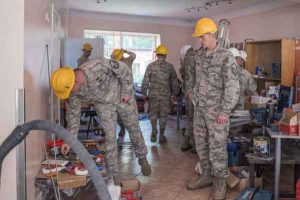
RIGA, Latvia — He wasn’t the one you’d pin as a construction worker, much less in Latvia. You know the type — the lanky, quiet one who surprised you when he made a joke.
But there he was, twenty-two-year-old Clint Heller on his maiden voyage overseas, applying himself to train not only in his sister-field of electrical engineering, but pitching in with the diverse trades among his 176th Civil Engineer Squadron comrades.
Senior Airman Heller is a power productions journeyman with a whopping three years of military experience since joining the Alaska Air National Guard in 2014. Raised in Wasilla, Alaska, he hadn’t ventured too far from home before the military. His training has taken him from coast to coast within the U.S, and now overseas.
“I’ve done more traveling with the military than I ever have before,” Heller said. “It’s one of the reasons I joined.”
Among the motivations that brought Heller to the mash of cultures in the Latvian capital was to become more outgoing, he said, for the sense of pride and to serve his country.
And serving he is. Heller, along with thirty-three other 176th CES and support unit members, are repairing a children’s rehabilitation center here during their two-week annual training as part of a humanitarian-civic assistance (HCA) project.
“I think it’s a pretty important job,” Heller said. “It’s definitely overdue.”
With poor lighting, wind whistling between window sills and rotting wood holding up the awnings, the teachers were unable to fully use the facilities to assist their children with disabilities. But they couldn’t stop, said Andra Greitane, the director of the center. The parents had to work, and the children needed care.[xyz-ihs snippet=”Adsense-responsive”]The construction project began on June 26. The Alaska Airmen are the third rotation of Air National Guardsmen on the project, working alongside Latvian military and contractors to upgrade the aging building. Part of the experience is learning to work with U.S. allies, overcoming language barriers and varying construction standards.
Training in a foreign environment with limited access to tools and materials is a main objective for the mission, intended to challenge the Airmen, making them well-rounded.
“They’re going to face the same challenges when they get deployed,” said Chief Master Sgt. Keith Wilson, the chief enlisted manager of the 176th CES. “And when they get deployed, I want to be confident in their abilities.”
The Air Guardsmen will take the skills they gained back home and use them in Alaska, as well. Whether it’s routine maintenance or a state emergency, the Alaska National Guard stands ready.
“If Alaska ever had a natural disaster, we’d be there first,” Heller said. “It’s nice being first responders to protect Alaska. I take a lot of pride being from Alaska.”
